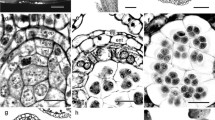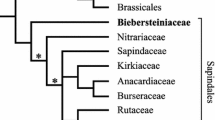Abstract
Pera is a neotropical genus that currently belongs to the family Peraceae. This circumscription resulted from an inclusion of the Rafflesiaceae between the old tribe Pereae and all other Euphorbiaceae, and wherein Pereae was elevated to family rank making Euphorbiaceae monophyletic again. These changes are necessary although Rafflesiaceae are holoparasitic with extremely reduced vegetative bodies and large flowers while Peraceae and Euphorbiaceae have well developed vegetative parts and reduced flowers. As the embryology of Peraceae was poorly known, and embryological processes are conservative, we studied the embryology of Pera glabrata, searching for similarities between Peraceae, Rafflesiaceae, and Euphorbiaceae that could support this grouping. Usual methods of light microscopy and scanning electron microscopy were utilised. The results show endothecium with reversed-T-shaped cells, prismatic crystals in the tapetum, and disintegrated aerenchymatous septum in the mature fruit as unique features for Peraceae and possibly apomorphies for the family. In addition to the unisexual flowers, porogamous fertilization is present and one ovule per carpel which may support the Peraceae–Rafflesiaceae–Euphorbiaceae clade. The comparative approach also suggests possible (syn-)apomorphies for linoids and phyllanthoids, only linoids, Rafflesiaceae, Euphorbiaceae, and Ixonanthaceae. The presence of a placental obturator found previously unknown in Peraceae emerged as a possible synapomorphy for the euphorbioids (including Ixonanthaceae, Linaceae, Phyllanthaceae, Picrodendraceae, Peraceae, Rafflesiaceae, and Euphorbiaceae), which appeared in a common ancestor of the group and has been lost in Rafflesiaceae.







Similar content being viewed by others
References
Berg R (1975) Fruit, seed and myrmecochorous dispersal in Micrantheum (Euphorbiaceae). Norw J Bot 22:173–194
Berlyn GP, Miksche JP (1976) Botanical microtechnique and cytochemistry. Iowa State University Press, Ames
Bhanwra R (1987) Embryology of Euphorbia maddeni and Euphorbia nivulia. Curr Sci 56:1062–1064
Bigio N, Secco R (2012) As espécies de Pera (Euphorbiaceae s.s) na Amazônia brasileira. Rodriguésia 63:163–207. doi:10.1590/S2175-78602012000100012
Boesewinkel FD (1988) Development of ovule and testa of Linum usitatissimum L. Acta Bot Neerl 29:17–32. doi:10.1111/j.1438-8677.1980.tb01185.x
Bouman F, Meijer W (1994) Comparative structure of ovules and seeds in Rafflesiaceae. Plant Syst Evol 193:187–212. doi:10.1007/BF00983550
Cave MS (1953) Cytology and embryology in the delimitation of genera. Chron Bot 14:140–153
Corner EJH (1976) The seeds of dicotyledons, vol 1 and 2. Cambridge University Press, Cambridge
Davis GL (1966) Systematic embryology of the angiosperms. Wiley, New York
Davis PH, Heywood VH (1963) Principles of angiosperm taxonomy. Van Nostrand, Princeton
De-Paula OC, Sajo MG (2011) Morphology and development of anthers and ovules in Croton and Astraea (Euphorbiaceae). Nord J Bot 29:505–511. doi:10.1111/j.1756-1051.2011.01072.x
Dressler S, Repplinger M, Bayer C (2014) Linaceae. In: Kubitzki K (ed) Eudicots—malpighiales, vol. 11. The families and genera of vascular plants. Springer, Berlin, pp 237–246. doi:10.1007/978-3-642-39417-1
Endress PK, Stumpf S (1990) Non-tetrasporangiate stamens in the angiosperms: structure, systematic distribution and evolutionary aspects. Bot Jahrb Syst 112:193–240
Endress PK, Davis CC, Matthews ML (2013) Advances in the floral structural characterization of the major subclades of Malpighiales, one of the largest orders of flowering plants. Ann Bot 111:961–985. doi:10.1093/aob/mct056
Ernst A, Schmid E (1909) Embryosackentwicklung und Befruchtung bei Rafflesia patma Bl. Ber Deut Bot Ges 27:176–186. doi:10.1111/j.1438-8677.1909.tb06784.x
Ernst A, Schmid E (1913) Über Blüte und Frucht von Rafflesia. Morphologisch-biologische Beobachtungen und entwicklungsgeschichtlich-zytologische Untersuchungen. Ann Jard Bot Buitenzorg 27:1–55
Furness CA (2007) Why does some pollen lack apertures? A review of inaperturate pollen in eudicots. Bot J Linn Soc 155:28–48. doi:10.1111/j.1095-8339.2007.00694.x
Gopinath D, Gopalkrishnan K (1949) The ovule and the development of the female gametophyte in Homonoia retusa Muell, and Euphorbia oreophila Miquel. Am Midl Nat 41:759–764
Igersheim A, Endress PK (1998) Gynoecium diversity and systematics of the paleoherbs. Bot J Linn Soc 127:289–370. doi:10.1006/bojl.1998.0180
Johansen DA (1940) Plant microtechnique. McGraw-Hill Book Company, New York
Johri BM, Kapil RN (1953) Contribution to the morphology and life history of Acalypha indica L. Phytomorphology 3:137–151
Johri BM, Ambegaokar KB, Srivastava PS (1992) Comparative embryology of angiosperms. Springer, Berlin. doi:10.1007/978-3-642-76395-3
Kapil RN, Bhatnagar AK (1994) The contribution of embryology to the systematics of the Euphorbiaceae. Ann Mo Bot Gard 81:145–159. doi:10.2307/2992091
Kool R (1988) A taxonomic revision of the genus Ixonanthes (Linaceae). Blumea 26:191–204
Kubitzki K (2014) Ixonanthaceae. In: Kubitzki K (ed) Eudicots—malpighiales, vol. 11. The families and genera of vascular plants. Springer, Berlin, pp 233–236. doi:10.1007/978-3-642-39417-1
Landes M (1946) Seed development in Acalypha rhomboidea and some other Euphorbiaceae. Am J Bot 33:562–568
Liu HF, Kirchoff BK, Wu GJW, Liao JP (2007) Microsporogenesis and male gametogenesis in Jatropha curcas L. (Euphorbiaceae). J Torrey Bot Soc 134:335–343. doi:10.3159/1095-5674(2007)134[335:MAMGIJ]2.0.CO;2
Meijer W (1993) Rafflesiaceae. In: Kubitzki K, Rohwer JG, Bittrich V (eds) Dicotyledons—magnoliid, hamamelid and caryophyllid, vol 2. The families and genera of vascular plants. Springer, Berlin, pp 557–563. doi:10.1007/978-3-662-02899-5
Mukherjee P (1961) Embryology of two Euphorbiaceae. Proc Indian Acad Sci B 53:217–229
Mukherjee PK, Padhye MD (1964) Contribution to the embryology of the genus Phyllanthus Linn. Proc Natl Acad Sci India B 34:117–128
Nair N, Maitreyi M (1962) Morphology and embryology of Sebastiania chamaelea. Bot Gaz 124:58–68
Narayana LL (1964) A contribution to the floral anatomy and embryology of Linaceae. J Indian Bot Soc 43:343–357
Nikolov LA, Staedler YM, Manickam S, Schönenberger J, Endress PK, Kramer EM, Davis CC (2014a) Floral structure and development in Rafflesiaceae with emphasis on their exceptional gynoecia. Am J Bot 101:225–243. doi:10.3732/ajb.1400009
Nikolov LA, Tomlinson PB, Manickam S, Endress PK, Kramer EM, Davis CC (2014b) Holoparasitic Rafflesiaceae possess the most reduced endophytes and yet give rise to the world’s largest flowers. Ann Bot 114:233–242. doi:10.1093/aob/mcu114
Nowicke JW (1994) A palynological study of Crotonoideae (Euphorbiaceae). Ann Missouri Bot Gard 81:245–269. doi:10.2307/2992096
Nowicke JW, Takahashi M (2002) Pollen morphology, exine structure and systematics of Acalyphoideae (Euphorbiaceae), Part 4: Tribes Acalypheae pro parte (Erythrococca, Claoxylon, Claoxylopsis, Mareya, Mareyopsis, Discoclaoxylon, Micrococca, Amyrea, Lobanilia, Mallotus, Deuteromallotus, Cordemoya, Coccoceras, Trewia, Neotrewia, Rockinghamia, Octospermum, Acalypha, Lasiococca, Spathiostemon, Homonoia), Plukenetieae (Haematostemon, Astrococcus, Angostyles, Romanoa, Eleutherostigma, Plukenetia, Vigia, Cnesmone, Megistostigma, Sphaerostylis, Tragiella, Platygyna, Tragia, Acidoton, Pachystylidium, Dalechampia), Omphaleae (Omphalea), and discussion and summary of the complete subfamily. Rev Palaeobot Palynol 121:231–336. doi:10.1016/S0034-6667(02)00087-8
Nowicke JW, Takahashi M, Webster GL (1998) Pollen morphology, exine structure and systematics of Acalyphoideae (Euphorbiaceae) Part 1. Tribes Clutieae (Clutia), Pogonophoreae (Pogonophora), Chaetocarpeae (Chaetocarpus, Trigonopleura), Pereae (Pera), Cheiloseae (Cheilosa, Neoscortechinia), Erismantheae pro parte (Erismanthus, Moultonianthus), Dicoelieae (Dicoelia), Galearieae (Galearia, Microdesmis, Panda) and Ampereeae (Amperea, Monotaxis). Rev Palaeobot Palynol 102:115–152. doi:10.1016/S0034-6667(98)80001-8
Nowicke JW, Takahashi M, Webster GL (1999) Pollen morphology, exine structure and systematics of Acalyphoideae (Euphorbiaceae): Part 2. Tribes Agrostistachydeae (Agrostistachys, Pseudagrostistachys, Cyttaranthus, Chondrostylis), Chrozophoreae (Speranskia, Caperonia, Philyra, Ditaxis, Argythamnia, Chiropetalum, Doryxylon, Sumbaviopsis, Thyrsanthera, Melanolepis, Chrozophora), Caryodendreae (Caryodendron, Discoglypremna, Alchorneopsis), Bernardieae (Bernardia, Necepsia, Paranecepsia, Discocleidion, Adenophaedra) and Pycnocomeae (Pycnocoma, Droceloncia, Argomuellera, Blumeodendron, Podadenia, Ptychopyxis, Botryophora). Rev Palaeobot Palynol 105:1–62. doi:10.1016/S0034-6667(98)00069-4
O’Brien TP, Feder N, McCully ME (1964) Polychromatic staining of plant cell walls by toluidine blue O. Protoplasma 59:368–373. doi:10.1007/BF01248568
Palser BF (1975) The bases of angiosperm phylogeny: embryology. Ann Mo Bot Gard 62:621–646
Radcliffe-Smith A (2001) Genera Euphorbiacearum. Royal Botanic Gardens, Kew
Rao A (1964) Notes on the embryology of Hevea brasiliensis Muell. Curr Sci 33:739–740
Rao D, Narayana LL (1965) Embryology of Linaceae. Curr Sci 34:92–93
Rao PN, Rao DS (1976) Embryology of cassava. Proc Indian Acad Sci Sect B Biol Sci 42:111–116
Schnarf K (1931) Vergleichende Embryologie der Angiospermen. Bornträger, Berlin
Sharma G (1956) Studies in the family Euphorbiaceae 1. The gametophytes of Chrozophora rottleri A. Juss. J Indian Bot Soc 35:189–193
Stuessy TF (2009) Plant taxonomy: the systematic evaluation of comparative data. Columbia University Press, New York
Sutter D, Endress PK (1995) Aspects of gynoecium structure and macrosystematics in Euphorbiaceae. Bot Jahrb Syst 116:517–536
Sutter DM, Forster PI, Endress PK (2006) Female flowers and systematic position of Picrodendraceae (Euphorbiaceae s.l., Malpighiales). Pl Syst Evol 261:187–215. doi:10.1007/s00606-006-0414-0
Takahashi M, Nowicke JW, Webster GL, Orli SS, Yankowski S (2000) Pollen morphology, exine structure, and systematics of Acalyphoideae (Euphorbiaceae), part 3: Tribes Epiprineae (Epiprinus, Symphyllia, Adenochlaena, Cleidiocarpon, Koilodepas, Cladogynos, Cephalocrotonopsis, Cephalocroton, Cephalomappa), Adelieae (Adelia, Crotonogynopsis, Enriquebeltrania, Lasiocroton, Leucocroton), Alchorneae (Orfilea, Alchornea, Coelebogyne, Aparisthmium, Bocquillonia, Conceveiba, Gavarretia), Acalypheae pro parte (Ricinus, Adriana, Mercurialis, Leidesia, Dysopsis, Wetria, Cleidion, Sampantaea, Macaranga). Rev Palaeobot Palynol 110:1–66. doi:10.1016/S0034-6667(99)00061-5
Takhtajan AL, Meyer NR, Kosenko VN (1979) Morphology of pollen grains of the family Hydnoraceae in relation to its systematic position. Bot Zhurn (Moscow &Leningrad) 64:1774–1777
Tobe H (1989) The embryology of angiosperms: its broad application to the systematic and evolutionary study. Bot Mag Tokyo 102:351–367. doi:10.1007/BF02488572
Tokuoka T, Tobe H (1998) Ovules and seeds in Crotonoideae (Euphorbiaceae): structure and systematic implications. Bot Jahrb Syst 120:164–186
Tokuoka T, Tobe H (2001) Ovules and seeds in subfamily Phyllanthoideae (Euphorbiaceae): structure and systematic implications. J Plant Res 114:75–79. doi:10.1007/PL00013970
Tokuoka T, Tobe H (2002) Ovules and seeds in Euphorbioideae (Euphorbiaceae): structure and systematic implications. J Plant Res 115:361–374. doi:10.1007/s10265-002-0047-5
Tokuoka T, Tobe H (2003) Ovules and seeds in Acalyphoideae (Euphorbiaceae): structure and systematic implications. J Plant Res 116:355–380. doi:10.1007/s10265-003-0116-4
Webster GL (1994) Classification of the Euphorbiaceae. Ann Mo Bot Gard 81:3–32. doi:10.2307/2399908
Wurdack KJ, Davis CC (2009) Malpighiales phylogenetics: gaining ground on one of the most recalcitrant clades in the angiosperm tree of life. Am J Bot 96:1551–1570. doi:10.3732/ajb.0800207
Xi Z, Ruhfel BR, Schaefer H, Amorim AM, Sugumaran M, Wurdack KJ, Endress PK, Matthews ML, Stevens PF, Mathews S, Davis CC (2012) Phylogenomics and a posteriori data partitioning resolve the Cretaceous angiosperm radiation Malpighiales. Proc Natl Acad Sci USA 109:17519–17524. doi:10.1073/pnas.1205818109
Acknowledgements
The study was supported by Conselho Nacional de Desenvolvimento Cientifico e Tecnológico (CNPq no. 484376/2013-6). The authors thank Glein Monteiro de Araújo for help in locating the species and the Laboratório Multiusuário de Microscopia Eletrônica of the Faculdade de Engenharia Química (UFU) for technical support with the SEM. We also thank two anonymous reviewers for their comments on the manuscript.
Author information
Authors and Affiliations
Corresponding author
Rights and permissions
About this article
Cite this article
de Olivera Franca, R., De-Paula, O.C. Embryology of Pera (Peraceae, Malpighiales): systematics and evolutionary implications. J Plant Res 130, 709–721 (2017). https://doi.org/10.1007/s10265-017-0916-6
Received:
Accepted:
Published:
Issue Date:
DOI: https://doi.org/10.1007/s10265-017-0916-6




